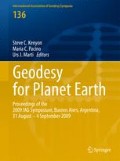Abstract
Modern satellite gravity field recovery missions use accelerometric, intersatellite tracking or gradiometric observables for deducing gravity field related data. In this study an alternative observable type for gravity field recovery, the relativistic frequency shift, is investigated. As Einstein stated in his general theory of relativity, gravity can be considered as attribute of space-time. In this view mass alters the geometric shape of the metric tensor. Moreover mass, respectively gravity, has effects on electromagnetic wave propagation [Einstein (Annalen der Physik 35:898–908 1911)]. Although these relativistic effects are quite small and difficult to measure, with upcoming atomic clocks which have sufficient accuracy and short-term stability it will be possible to derive meaningful gravity related information. Since relativistic effects are used this method is called Post-Newtonian method. The main target of this paper is to demonstrate the validity of the derived relativistic equations.
The scientific quality of the relativistic frequency shift observed by means of highly accurate atomic clocks is investigated. In our basic scenario a low earth orbit (LEO) sends an electromagnetic wave to a receiver. The reference station determines the frequency shift of the signal, which is connected to the time dilatation between the atomic clock of the satellite and an identical atomic clock nearby the receiver. A simplified, mathematical model for numerical simulations of this configuration is presented. The effect of different error sources are investigated by numerical closed-loop simulations. Thus, the performance requirements of atomic clocks, position and velocity determination and limiting factors for deducing earth’s gravity field can be derived.
Access this chapter
Tax calculation will be finalised at checkout
Purchases are for personal use only
References
Cacciapuoti L (2006) Atomic Clocks in Space. ESA-ESTEC (SCI-SP), Frascati
Doppler C (1842) Ueber das farbige Licht der Doppelsterne und einiger anderer Gestirnen des Himmels. Abhandlungen der k. böhm. Gesellschaft der Wissenshaften Folge V Band 2, In Commision bei Borrosch & André, Prag
Einstein A (1911) Über den Einfluß der Schwerkraft auf die Ausbreitung des Lichtes. Annalen der Physik 35, Verlag von Johann Ambrosius Barth, Leipzig pp 898–908
Einstein A (1916) Die Grundlage der allgemeinen Relativitätstheorie. Annalen der Physik 49, Verlag von Johann Ambrosius Barth, Leipzig pp 769–821
Gulkett M (2003) Relativistic effects in GPS and LEO. Rapport for the Cand. Scient. degree, University of Copenhagen, Department of Geophysics, The Niels Bohr Institute for Physics, Astronomy and Geophysics, Denmark
Heiskanen WA, and Moritz H (1967). Physical Geodesy. W. H. Freeman & Co Ltd, San Francisco, ISBN-13 978–0716702337
Müller J, Soffel M and Klioner SA (2007) Geodesy and relativity. Journal of Geodesy 82 Number 3, Springer, Berlin, ISSN 0949–7714, pp 133–145
Schiller S (2007) Gravimetry with optical clocks. Workshop on The Future of Satellite Gravimetry 12–13 April 2007, ESTEC
Schiller S, Tino GM, Gill P, Salomon C, Sterr U, Peik E, Nevsky A, Görlitz A, Svehla D, Ferrari G, Poli N, Lusanna L, Klein H, Margolis H, Lemonde P, Laurent P, Santarelli G, Clairon A, Ertmer W, Rasel E, Müller J, Iorio L, Lämmerzahl C, Dittus H, Gill E, Rothacher M, Flechner F, Schreiber U, Flambaum V, Ni, Wei-Tou, Liu, Liang, Chen, Xuzong, Chen, Jingbiao, Gao, Kelin, Cacciapuoti L, Holzwarth R, Heß MP, Schäfer W (2009) Einstein gravity explorer – a medium class fundamental physics mission. Exp Astron 23 (2):573–610
Shin MY, Park C and Lee SJ (2008) Atomic Clock Error Modeling for GNSS Software Platform. Position, Location and Navigation Symposium, IEEE/ION Plans 2008, pp 71–76, 1-4244-1537-03/08
Schuh W-D (2001) Improved modeling of SGG-data sets by advanced filter strategies. ESA-Project (Hg.): From Eötvös to mGal+, WP2, Midterm-Report, pp 113–181
Soffel M, Klioner A, Petit G, Wolf P, Kopeikin SM, Bretagnon P, Brumberg VA, Capitaine N, Damour T, Fukushima T, Guinot B, Huang T-Y, Lindegren L, Ma C, Nordtvedt K, Ries JC, Seidelmann PK, Vokrouhlicky D, Will CM, Xu C (2003) The IAU 2000 resolution for astrometry, celestial mechanics, and metrology in the framework: explanatory supplement. Astron J 126:2687–2706, The American Astronomical Society. USA
Acknowledgements
We would like to thank L. Vitushkin and an anonymous reviewer for their valuable comments which helped to improve the manuscript.
Author information
Authors and Affiliations
Corresponding author
Editor information
Editors and Affiliations
Rights and permissions
Copyright information
© 2012 Springer-Verlag Berlin Heidelberg
About this paper
Cite this paper
Mayrhofer, R., Pail, R. (2012). Future Satellite Gravity Field Missions: Feasibility Study of Post-Newtonian Method. In: Kenyon, S., Pacino, M., Marti, U. (eds) Geodesy for Planet Earth. International Association of Geodesy Symposia, vol 136. Springer, Berlin, Heidelberg. https://doi.org/10.1007/978-3-642-20338-1_28
Download citation
DOI: https://doi.org/10.1007/978-3-642-20338-1_28
Published:
Publisher Name: Springer, Berlin, Heidelberg
Print ISBN: 978-3-642-20337-4
Online ISBN: 978-3-642-20338-1
eBook Packages: Earth and Environmental ScienceEarth and Environmental Science (R0)

